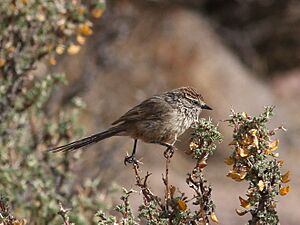Plain-mantled tit-spinetail facts for kids
Quick facts for kids Plain-mantled tit-spinetail |
|
|---|---|
 |
|
| Conservation status | |
| Scientific classification | |
| Genus: |
Leptasthenura
|
| Species: |
aegithaloides
|
 |
|
| Range of L. a. aegithaloides and L. a. grisescens; see the Taxonomy and Distribution sections. | |
The plain-mantled tit-spinetail (Leptasthenura aegithaloides) is a small bird found in South America. It belongs to the ovenbird family, called Furnariidae. You can find this bird in countries like Argentina, Bolivia, Chile, and Peru.
Contents
Understanding the Plain-Mantled Tit-Spinetail
How Scientists Classify This Bird
Scientists sometimes have different ideas about how to group animals. For the plain-mantled tit-spinetail, most groups agree it has four main types, called subspecies. These are like different versions of the same bird.
The four subspecies are:
- L. a. grisescens
- L. a. berlepschi
- L. a. aegithaloides (this is the main type)
- L. a. pallida
However, another group, BirdLife International, thinks that two of these types (L. a. berlepschi and L. a. pallida) are actually separate species. For this article, we will follow the idea that it is one species with four subspecies.
What Does This Bird Look Like?
The plain-mantled tit-spinetail is a small, thin bird with a long tail and a short beak. It is about 15 to 17 centimeters (6 to 7 inches) long. It weighs between 7.5 and 11 grams (about 0.26 to 0.39 ounces). Both male and female birds look the same.
The main type, L. a. aegithaloides, has a white stripe above its eye. Its face is dark brownish with white streaks. The top of its head is dark brown with wide golden-brown streaks. Its back and tail feathers are dull brownish. Its tail is long and looks forked. Its throat is whitish, and its chest is dull grayish-brown.
Differences in Subspecies
- L. a. grisescens is lighter in color than the main type. It has wider stripes on its head and a grayer back.
- L. a. berlepschi is a bit bigger. It has a lighter cinnamon-colored head with strong streaks. Its underside is entirely buffy (a pale yellowish-brown).
- L. a. pallida has the longest tail of all the subspecies. Its back is mostly pale gray. Its belly is pale gray, sometimes with a buffy wash.
Where Do These Birds Live?
The different types of plain-mantled tit-spinetails live in various parts of South America.
- The main type, L. a. aegithaloides, lives in central Chile.
- L. a. grisescens lives along the coast from Peru south into northern Chile.
- L. a. berlepschi is found in the Andes mountains in southern Peru, northern Chile, western Bolivia, and northwestern Argentina.
- L. a. pallida lives from northern Argentina and southern Chile all the way down to Tierra del Fuego.
Their Homes and Habitats
These birds live in different kinds of places:
- The main type and L. a. grisescens like dry scrublands and open forests. They can also be found in parks and farms. They live from sea level up to about 2,500 meters (8,200 feet) high.
- L. a. berlepschi lives in high grasslands and scrublands of the Altiplano (a high plateau). It prefers elevations from about 3,500 to 4,300 meters (11,500 to 14,100 feet).
- L. a. pallida lives in scrublands and woodlands. It can also be found on salt flats. It lives from sea level up to 700 meters (2,300 feet) high.
Plain-Mantled Tit-Spinetail Behavior
How They Move Around
Some plain-mantled tit-spinetails move to different areas depending on the season.
- The main type is partly migratory. Some birds move north or to lower elevations after breeding.
- L. a. grisescens moves between different green areas in the desert.
- L. a. berlepschi is thought to stay in the same area all year.
- The southern L. a. pallida birds move north, but scientists are still learning about their travels.
What They Eat
The plain-mantled tit-spinetail eats small bugs and other arthropods. It usually hunts for food in pairs or small family groups. In the non-breeding season, they might gather in flocks of up to 40 birds. They often join other bird species to find food together.
They look for food from the ground all the way up to the tops of trees. They usually pick their prey from leaves, flowers, twigs, and branches. Sometimes, they even hang upside down to reach their meal!
Reproduction and Nests
The plain-mantled tit-spinetail breeds during the spring and summer in the southern parts of the world. They are believed to stay with one partner.
They build a cup-shaped nest using twigs, grasses, hair, and feathers. They like to build their nests inside holes. These can be natural holes in trees or cacti, old woodpecker holes, or even cracks in rocks, cliffs, or buildings. The main type has even been seen nesting inside the nests of larger birds like the variable hawk or the monk parakeet! They usually lay two to four eggs. Scientists are still learning about how long the eggs take to hatch and how the parents care for their young.
Their Calls and Songs
The different subspecies of the plain-mantled tit-spinetail have unique voices.
- The main type's song is a high-pitched, descending, broken trill. It sounds like "chikiti-chikiti-chikiti-chikiti-ti-ti-ti-pweew-ti-ti-ti-pweew-ti-ti-ti…". Its calls include a short, nasal trill like "prrr" and a double "tzk-tzk".
- L. a. grisescens's song is similar but faster and even higher-pitched. Its calls are a short chatter like "tchi-chi-chi-chi-chi".
- L. a. berlepschi's song is a buzzing chatter or a descending tinkling trill. Its call is a short, descending trill.
- L. a. pallida's song is a lively chatter, higher-pitched and more musical. Its call is a high-pitched, buzzing chatter.
Conservation Status
The plain-mantled tit-spinetail is considered a species of "Least Concern" by the IUCN (International Union for Conservation of Nature). This means that its population is stable, and it is not currently at risk of disappearing. All four subspecies are quite common in many areas where they live. They can also handle some changes to their habitat. They are found in at least one protected area, which helps keep them safe.


